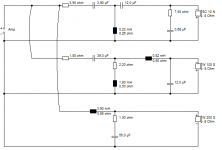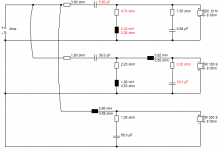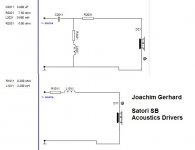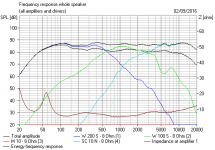I am thinking of building these for my next set of speakers mainly for music listening. This is going to be my first multi-way build so I am looking for a proven design. I want to know your opinion how much they would differ in sound & performance. See link below:
SEAS-3-Way-Classic
SEAS-3-Way-Classic-mkII
Both are using the same mids (MCA12RC) & tweeters (27TFFC) with a slight difference in model for the woofers (CA22RNX for MkI & CA22RNY for MkII). Troels' said that the crossover & stepped baffle changes he made for MkII yield better performance. BUT the Mark 2 version is a "closed kit", he doesn't share the crossover values unless you buy the kit from his partner audio store. While the data for the Mark 1 version is available for everyone.
I am leaning towards the Mark 1 version because the shipping & duties cost to my country is going to be a significant amount, I am confident I can get the drivers & other parts locally or in Singapore where I frequently visit. I want to know if I will be missing out on the "better" performance of Mark 2 version & will regret it later on.
Would greatly appreciate if you can share your thoughts. Thanks!
SEAS-3-Way-Classic
SEAS-3-Way-Classic-mkII
Both are using the same mids (MCA12RC) & tweeters (27TFFC) with a slight difference in model for the woofers (CA22RNX for MkI & CA22RNY for MkII). Troels' said that the crossover & stepped baffle changes he made for MkII yield better performance. BUT the Mark 2 version is a "closed kit", he doesn't share the crossover values unless you buy the kit from his partner audio store. While the data for the Mark 1 version is available for everyone.
I am leaning towards the Mark 1 version because the shipping & duties cost to my country is going to be a significant amount, I am confident I can get the drivers & other parts locally or in Singapore where I frequently visit. I want to know if I will be missing out on the "better" performance of Mark 2 version & will regret it later on.
Would greatly appreciate if you can share your thoughts. Thanks!
I usually find that it is cheaper to buy Troels' kits from Jantzen in Poland than to buy all the parts separately myself in USA, even including the shipping and import duties. You might ask them for a quote and compare to buying locally before you make your decision.
Without reading the articles I can see that the mid/tweeter in mk2 are time aligned with tweeter on a recessed baffle, so this is a totally different crossover design. He would not take the trouble to do a whole new speaker if there was not significant gains. I would go with the mk2.
If you use Jantzen kit PLEASE do not use the speaker binding posts. They are the same cheap junk, injection molded zinc pot metal sold for $6 pair at Parts Express. They sound terrible and break off when tightening them on installation. I can't believe he uses those on these multi-thousand dollar kits with finest drivers and xo parts. Good copper posts are worth the investment.
Without reading the articles I can see that the mid/tweeter in mk2 are time aligned with tweeter on a recessed baffle, so this is a totally different crossover design. He would not take the trouble to do a whole new speaker if there was not significant gains. I would go with the mk2.
If you use Jantzen kit PLEASE do not use the speaker binding posts. They are the same cheap junk, injection molded zinc pot metal sold for $6 pair at Parts Express. They sound terrible and break off when tightening them on installation. I can't believe he uses those on these multi-thousand dollar kits with finest drivers and xo parts. Good copper posts are worth the investment.
In all probability, the greatest advantage of mkII over the basic version
would be greater sensitivity. Both of the woofers exhibit good transducer
capabilities. Troels Gravesen can't possibly afford that either of his free kits
sounds substantially worse than the ones you have to pay extra for. That
would be a very bad business move. So, if the price difference is something
you find acceptable, go for it.
would be greater sensitivity. Both of the woofers exhibit good transducer
capabilities. Troels Gravesen can't possibly afford that either of his free kits
sounds substantially worse than the ones you have to pay extra for. That
would be a very bad business move. So, if the price difference is something
you find acceptable, go for it.
Hi Richidoo! Thank you for your input.
I have family members based in Singapore where there is a local SEAS distributor and their prices is comparable to that of Madisound's listed price before shipping cost & import duties. I can also buy the crossover parts from them for a very competitive price as they are official reseller of Jantzen Audio. That's the main reason I'm highly considering Troels' 3 way classic.
Yes, I agree that the Mark II is a new crossover design with time alignment implementation which is also the main reason why I'm thinking I can just buy the kit minus the drivers from Jantzen Audio and just accept the 100+ euro shipping cost & additional custom duties. I'm just wondering if the performance of the new design is worth the extra cost.
Other are welcome to chime in.
I have family members based in Singapore where there is a local SEAS distributor and their prices is comparable to that of Madisound's listed price before shipping cost & import duties. I can also buy the crossover parts from them for a very competitive price as they are official reseller of Jantzen Audio. That's the main reason I'm highly considering Troels' 3 way classic.
Yes, I agree that the Mark II is a new crossover design with time alignment implementation which is also the main reason why I'm thinking I can just buy the kit minus the drivers from Jantzen Audio and just accept the 100+ euro shipping cost & additional custom duties. I'm just wondering if the performance of the new design is worth the extra cost.
Other are welcome to chime in.
Hi Lojzek,
What you said makes sense...I'm still trying to convince myself that the extra cost would be worth it but I'm now strongly considering the Mark II.
Thanks for sharing your thoughts.
What you said makes sense...I'm still trying to convince myself that the extra cost would be worth it but I'm now strongly considering the Mark II.
Thanks for sharing your thoughts.
Yes, I agree that the Mark II is a new crossover design with
time alignment implementation which is also the main reason...
The basic version is compensated through the asymmetrical
XO filter. 2nd order electrical (mid) and 3rd order (tw).
Three thoughts:
1) You might want to spend a few nights trying to duplicate the Classic mkII crossover slopes using Xsim + Passive Crossover Design Calculator + Troels generous measurement data and Troels Xover circuits. The Seas datasheets provide impedance and SPL around the crossover frequency to run through the Design Calculator with LR2 circuits, and the 2-resistor L-Pad used on the tweeter. Work to mimic Troels measured data. I've done this for Troels SB-Acoustics 3-way.
2) What SHAPE - Do you REALLY favor:
-A large bookshelf speaker like the 3-way Classic on a stand; or
-A 3-way floor stander with the same foot print and superior bass; or
-A TM top cabinet, stacked on a woofer bottom cabinet with the same footprint and superior bass?(2.8cuft instead of 1.5cuft)
3) In their latest-and-greatest speaker designs, several experts including Troels, have moved away from the Classic 4" midrange with 2,700Hz crossover, to a latest-and-greatest-tech 6" midrange like the Satori 16MWP from SB-Acoustics, adding the SB23NRXS45-8 woofer, and SB29RDC-C000-4 tweeter for a 1800Hz lower crossover frequency. There are free professional designs like the Kalasan you can build. Spend $$ on a better midrange instead of on buying a Xover ckt.
SBAcoustics 10
Kairos + woofer (Google pdf)
Kalasan(free on diyAudio) + woofer(above)
1) You might want to spend a few nights trying to duplicate the Classic mkII crossover slopes using Xsim + Passive Crossover Design Calculator + Troels generous measurement data and Troels Xover circuits. The Seas datasheets provide impedance and SPL around the crossover frequency to run through the Design Calculator with LR2 circuits, and the 2-resistor L-Pad used on the tweeter. Work to mimic Troels measured data. I've done this for Troels SB-Acoustics 3-way.
2) What SHAPE - Do you REALLY favor:
-A large bookshelf speaker like the 3-way Classic on a stand; or
-A 3-way floor stander with the same foot print and superior bass; or
-A TM top cabinet, stacked on a woofer bottom cabinet with the same footprint and superior bass?(2.8cuft instead of 1.5cuft)
3) In their latest-and-greatest speaker designs, several experts including Troels, have moved away from the Classic 4" midrange with 2,700Hz crossover, to a latest-and-greatest-tech 6" midrange like the Satori 16MWP from SB-Acoustics, adding the SB23NRXS45-8 woofer, and SB29RDC-C000-4 tweeter for a 1800Hz lower crossover frequency. There are free professional designs like the Kalasan you can build. Spend $$ on a better midrange instead of on buying a Xover ckt.
SBAcoustics 10
Kairos + woofer (Google pdf)
Kalasan(free on diyAudio) + woofer(above)
The conversion from flat baffle SEAS-3-Way-Classic to 2cm LR2 stepped baffle is quite straightforward IMO. 🙂
On the left is the original 3 way classic style, and on the right the stepped baffle design. Joachim Gerhard used a tweeter circuit like that in his SB acoustics Satori design, but it does work the tweeter harder. And yes, Lojzek, it works beautifully with the cheapie Visaton drivers. 😀
On the left is the original 3 way classic style, and on the right the stepped baffle design. Joachim Gerhard used a tweeter circuit like that in his SB acoustics Satori design, but it does work the tweeter harder. And yes, Lojzek, it works beautifully with the cheapie Visaton drivers. 😀
Attachments
Hi,
I note that TG seems to have zero interest in the quite
appalling diffraction effects of the new stepped baffle
designs or even optimising the step angle. I really
don't like "head in the sand " attitudes, the most
infamous for me is Lynn Olson choosing to ignore
BSC completely in his relatively famous Ariel design.
rgds, sreten.
I note that TG seems to have zero interest in the quite
appalling diffraction effects of the new stepped baffle
designs or even optimising the step angle. I really
don't like "head in the sand " attitudes, the most
infamous for me is Lynn Olson choosing to ignore
BSC completely in his relatively famous Ariel design.
rgds, sreten.
He has performed and written up some studies, for example. To my eyes it looks ugly both aesthetically and functionally since the need would disappear with an active crossover. A good grille would help.I note that TG seems to have zero interest in the quite
appalling diffraction effects of the new stepped baffle
designs or even optimising the step angle.
Hi Linesource, thank you for taking the time to answer my question.
1) Honestly I haven't gotten to the point where I would reverse-engineer his crossover design, my thinking is if I decide to go with the Mark II then I will just get the closed kit from Jantzen Audio, the man also need to get compensated for his work and I respect that. My second thoughts about going with Mark II is if the new design is worth the extra cost for the build.
2) The reason why I decided to go with the 3 way bookshelf is the size of the room where I will be putting the speakers, which is small: 4mtrs X 5mtrs. I'm thinking a 3 way floorstander with a big enclosure for woofer will dominate & excite room modes more.
3) There has been a lot of good things being said here and other sites about SB Acoustic drivers, but sadly they aren't available locally. Importing these drivers will almost double the cost of the build.
Thanks.
1) Honestly I haven't gotten to the point where I would reverse-engineer his crossover design, my thinking is if I decide to go with the Mark II then I will just get the closed kit from Jantzen Audio, the man also need to get compensated for his work and I respect that. My second thoughts about going with Mark II is if the new design is worth the extra cost for the build.
2) The reason why I decided to go with the 3 way bookshelf is the size of the room where I will be putting the speakers, which is small: 4mtrs X 5mtrs. I'm thinking a 3 way floorstander with a big enclosure for woofer will dominate & excite room modes more.
3) There has been a lot of good things being said here and other sites about SB Acoustic drivers, but sadly they aren't available locally. Importing these drivers will almost double the cost of the build.
Thanks.
Three thoughts:
1) You might want to spend a few nights trying to duplicate the Classic mkII crossover slopes using Xsim + Passive Crossover Design Calculator + Troels generous measurement data and Troels Xover circuits. The Seas datasheets provide impedance and SPL around the crossover frequency to run through the Design Calculator with LR2 circuits, and the 2-resistor L-Pad used on the tweeter. Work to mimic Troels measured data. I've done this for Troels SB-Acoustics 3-way.
2) What SHAPE - Do you REALLY favor:
-A large bookshelf speaker like the 3-way Classic on a stand; or
-A 3-way floor stander with the same foot print and superior bass; or
-A TM top cabinet, stacked on a woofer bottom cabinet with the same footprint and superior bass?(2.8cuft instead of 1.5cuft)
3) In their latest-and-greatest speaker designs, several experts including Troels, have moved away from the Classic 4" midrange with 2,700Hz crossover, to a latest-and-greatest-tech 6" midrange like the Satori 16MWP from SB-Acoustics, adding the SB23NRXS45-8 woofer, and SB29RDC-C000-4 tweeter for a 1800Hz lower crossover frequency. There are free professional designs like the Kalasan you can build. Spend $$ on a better midrange instead of on buying a Xover ckt.
SBAcoustics 10
Kairos + woofer (Google pdf)
Kalasan(free on diyAudio) + woofer(above)
Last edited:
Between the 2 versions, which do you think is the better implementation? thanks.
The basic version is compensated through the asymmetrical
XO filter. 2nd order electrical (mid) and 3rd order (tw).
Thanks for sharing your thoughts, I have to ask you guys the same question: Is the new crossover & stepped baffle design for the version 2 worth the extra cost for me?
I have to be honest, I can't see by looking at the crossover schematics the advantage of one over the other, my knowledge is not up to that level yet. That's the reason why I am asking for your opinion. I appreciate your help.
I have to be honest, I can't see by looking at the crossover schematics the advantage of one over the other, my knowledge is not up to that level yet. That's the reason why I am asking for your opinion. I appreciate your help.
The conversion from flat baffle SEAS-3-Way-Classic to 2cm LR2 stepped baffle is quite straightforward IMO. 🙂
On the left is the original 3 way classic style, and on the right the stepped baffle design. Joachim Gerhard used a tweeter circuit like that in his SB acoustics Satori design, but it does work the tweeter harder. And yes, Lojzek, it works beautifully with the cheapie Visaton drivers. 😀
Hi,
I note that TG seems to have zero interest in the quite
appalling diffraction effects of the new stepped baffle
designs or even optimising the step angle. I really
don't like "head in the sand " attitudes, the most
infamous for me is Lynn Olson choosing to ignore
BSC completely in his relatively famous Ariel design.
rgds, sreten.
He has performed and written up some studies, for example. To my eyes it looks ugly both aesthetically and functionally since the need would disappear with an active crossover. A good grille would help.
It is a question for you to answer based on how you value things. TG considers the Mk II "better" and so if the extra cost is small and you are happy with the step in the baffle then that would seem the way to go. If the extra cost is not small then go for the Mk I.Thanks for sharing your thoughts, I have to ask you guys the same question: Is the new crossover & stepped baffle design for the version 2 worth the extra cost for me?
I don't understand sreten's remarks at all about Lynn Olson's bafflestep or Troel's diffraction considerations. Both look competent and considered to me. 🙂
But back to this 3 way. What 3 ways do well is go loud and undistorted, with flat power response, wide dispersion and good impedance.
I don't care for soft domes at all, and would prefer a metal tweeter here, a la Harbeth style. The H1212-06 27TBFC/G is a slot-in replacement for the H0881-06 27TFFC
Stepped baffle LR2 was a bit of a struggle to implement simply here, and the very shallow tweeter filter looks like one of those things you end up fiddling a lot with, as Joachim Gerhard did up to Kalasan 5 version, adding an Fs notch. TBH, I'd fancy the better power handling and lower distortion of the flat baffle version.
Troel's original flat baffle design is truly excellent IMO. Comparison below. Dotted lines are the original. Phase alignment is exemplary with either.
But back to this 3 way. What 3 ways do well is go loud and undistorted, with flat power response, wide dispersion and good impedance.
I don't care for soft domes at all, and would prefer a metal tweeter here, a la Harbeth style. The H1212-06 27TBFC/G is a slot-in replacement for the H0881-06 27TFFC
Stepped baffle LR2 was a bit of a struggle to implement simply here, and the very shallow tweeter filter looks like one of those things you end up fiddling a lot with, as Joachim Gerhard did up to Kalasan 5 version, adding an Fs notch. TBH, I'd fancy the better power handling and lower distortion of the flat baffle version.
Troel's original flat baffle design is truly excellent IMO. Comparison below. Dotted lines are the original. Phase alignment is exemplary with either.
Attachments
Did someone think to do a 3 Way classic from Troels but without the mono brand factor when choosing the drivers ?
I surmise for instance in the ScanSêak version or the AUdioTechnology version mediums drivers to be the best, but about the bass units and tweeters ?
@ System 7 (Hi), any thoughts ? A biger enclosure with a sealed bass ?
Well sorry if OT, here we are not in the kit anymore while possibly be very close when mixing the brands' units !
cheers
I surmise for instance in the ScanSêak version or the AUdioTechnology version mediums drivers to be the best, but about the bass units and tweeters ?
@ System 7 (Hi), any thoughts ? A biger enclosure with a sealed bass ?
Well sorry if OT, here we are not in the kit anymore while possibly be very close when mixing the brands' units !
cheers
Eldam,
For an individual looking to build a proven and solidly performing set of
speaker, it's essential to follow the speaker kit plans guidelines. On the
contrary, an experienced speaker designer, DIYer or not, understands that
it's not so important which brand you choose to work with, only that speaker
unit performance is reasonably similar, i.e. sensitivity, ts parameters, FR.
I have worked with so many different brands that I'm confident I am not
mistaken.
edit: @a3cervo
I haven't made any analysis in that sense to have a clear answer to your
question, which implementation might be better.
For an individual looking to build a proven and solidly performing set of
speaker, it's essential to follow the speaker kit plans guidelines. On the
contrary, an experienced speaker designer, DIYer or not, understands that
it's not so important which brand you choose to work with, only that speaker
unit performance is reasonably similar, i.e. sensitivity, ts parameters, FR.
I have worked with so many different brands that I'm confident I am not
mistaken.
edit: @a3cervo
I haven't made any analysis in that sense to have a clear answer to your
question, which implementation might be better.
Last edited:
So the choose of the load is more important : vented, sealed, open, cardioid, liters vs size of room, etc ? Is it just to choose the sensivity of the units ?
Distorsions of the drivers is overated ?
Finally did you find a FR curve which please you ?! I mean is it finally what we do when collectioning the speakers ??? Waste of time and money ?
Distorsions of the drivers is overated ?
Finally did you find a FR curve which please you ?! I mean is it finally what we do when collectioning the speakers ??? Waste of time and money ?

I am not paying too much attention to distortion curves for I care
mostly about the price range of speaker units, then I can think of
choosing one with better looking curves, but this is pretty much
not my primary concern. My philosophy has always been to bear
in mind that speakers are reproducers, so flat response on and
off-axis is ok. No, I don't think all the efforts in exploring the
options is a waste of time and money. It's all a very good school
where you learn much about human psychology. In the end you'll
reach the state of colmness knowing the truth. 😉
mostly about the price range of speaker units, then I can think of
choosing one with better looking curves, but this is pretty much
not my primary concern. My philosophy has always been to bear
in mind that speakers are reproducers, so flat response on and
off-axis is ok. No, I don't think all the efforts in exploring the
options is a waste of time and money. It's all a very good school
where you learn much about human psychology. In the end you'll
reach the state of colmness knowing the truth. 😉
- Home
- Loudspeakers
- Multi-Way
- Troels' Seas 3 Way Classic MkI vs MkII



